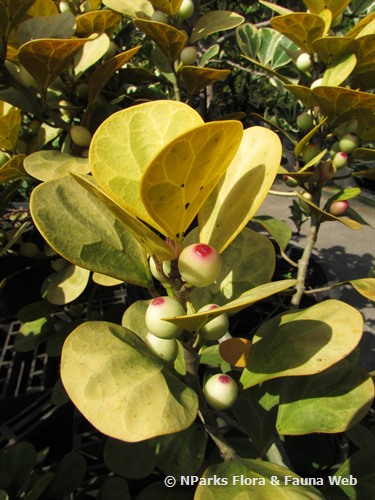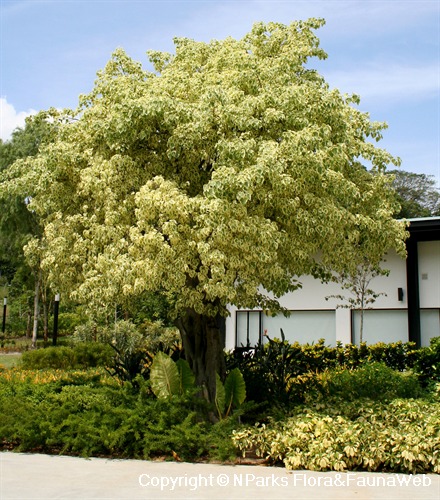
Back
Ficus consociata Blume
| Family Name: | Moraceae |
| Synonyms: | Ficus consociata var. murtonii King |
| Common Name: | Brown-Scurfy Fig, Pianggu Hutan |
Name
Classifications and Characteristics
| Plant Division | Angiosperms (Flowering Seed Plants) (Dicotyledon) |
|---|---|
| Plant Growth Form | Tree |
| Lifespan (in Singapore) | Perennial |
| Mode of Nutrition | Autotrophic |
| Plant Shape | Irregular |
Biogeography
| Native Distribution | Myanmar, Thailand, Cambodia, Peninsular Malaysia, Singapore, Sumatra, Borneo and Java. |
|---|---|
| Native Habitat | Terrestrial (Primary Rainforest, Secondary Rainforest, Monsoon Forest, Coastal Forest, Freshwater Swamp Forest, Riverine) |
| Preferred Climate Zone | Tropical, Sub-Tropical / Monsoonal |
| Local Conservation Status | Native to Singapore (Critically Endangered (CR)) |
Description and Ethnobotany
| Growth Form | It is a strangling fig with densely woolly twigs and leaves. |
|---|---|
| Foliage | Its alternate, stalked leaves have leathery leaf blades that are oblong to elliptic to slightly obovate, and are 5-27 cm by 2.5-14 cm. |
| Flowers | Its flowers are small and unisexual. It is a monoecious species, with both male and female flowers borne within a specialised body known as a syconium. |
| Fruit | Its stalkless syconia (figs) are borne on the twigs, and are round, 1.5 cm wide and ripen to red-orange when ripe. |
| Habitat | It grows in lowland forests, freshwater swamp forests, beside rivers, and coastal forests. It is found locally at Nee Soon Swamp Forest, Upper Seletar Reservoir and the Southern Islands. |
| Associated Fauna | Its figs are pollinated by fig wasps. Its ripe figs are eaten by birds. It is a host-plant for the moth Asota plana. |
| Cultivation | It can be propagated by seed, stem cuttings or air-layering. |
| Etymology | Latin Ficus, the commercial edible fig (Ficus carica); Latin consociata, forming clumps, referring to the figs being borne in close proximity to each other on the twigs. |
Landscaping Features
| Landscaping | It is suitable for parks for its ornamental leaves and figs. Its spreading roots have potential for stabilising slopes by planting them on top of slopes on flat ground and letting the roots run down. |
|---|---|
| Desirable Plant Features | Ornamental Foliage, Ornamental Fruits |
| Landscape Uses | General, Parks & Gardens, Coastal, Riverine, Shade Providing Tree / Palm, Reforestation, Slope Stabilization |
Fauna, Pollination and Dispersal
| Fauna Pollination Dispersal Associated Fauna | Bird-Attracting, Caterpillar Moth Food Plant |
|---|---|
| Pollination Method(s) | Biotic (Fauna) |
| Seed or Spore Dispersal | Biotic (Fauna) |
Plant Care and Propagation
| Light Preference | Full Sun, Semi-Shade |
|---|---|
| Water Preference | Moderate Water |
| Plant Growth Rate | Moderate |
| Rootzone Tolerance | Moist Soils, Well-Drained Soils, Fertile Loamy Soils |
| Transplanting Tolerance | Good |
| Maintenance Requirements | Moderate |
| Propagation Method | Seed, Stem Cutting |
Foliar
| Foliage Retention | Evergreen |
|---|---|
| Mature Foliage Colour(s) | Green |
| Mature Foliage Texture(s) | Velvety / Furry / Tomentose, Leathery |
| Prominent Young Flush Colour(s) | Green - Light Green |
| Young Flush Texture(s) | Velvety / Furry / Tomentose |
| Foliar Type | Simple / Unifoliate |
| Foliar Arrangement Along Stem | Alternate |
| Foliar Attachment to Stem | Petiolate |
| Foliar Shape(s) | Non-Palm Foliage (Obovate, Elliptical, Oblong) |
| Foliar Venation | Pinnate / Net |
| Foliar Margin | Entire |
Floral (Angiosperm)
| Flower & Plant Sexuality | Unisexual Flowers , Monoecious |
| Flower Grouping | Cluster / Inflorescence |
|---|
| Flower Location | Axillary |
| Inflorescence Type | Syconium |
Fruit, Seed and Spore
| Mature Fruit Colour(s) | Yellow / Golden, Orange, Red |
|---|---|
| Fruit Classification | Multiple Fruit |
| Fruit Type | Fleshy Fruit , Accessory / False Fruit (Pseudocarp) |
Image Repository
Others
| Master ID | 106 |
|---|---|
| Species ID | 1402 |
| Flora Disclaimer | The information in this website has been compiled from reliable sources, such as reference works on medicinal plants. It is not a substitute for medical advice or treatment and NParks does not purport to provide any medical advice. Readers should always consult his/her physician before using or consuming a plant for medicinal purposes. |













